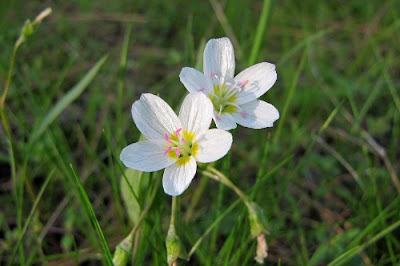

Last Friday, Anthony and I went to Wellpinit. During the drive, we passed a familiar stand of ponderosa pines, when I happened to notice a cluster of tiny white flowers growing on the forest floor. I'm not even sure how I saw them from my car, but they practically reached in and compelled me to stop. Once I took the time to observe them up close, I recognized them right away. Their scientific name is Claytonia lanceolata. Some people call them spring beauties, but I learned to know them as Indian potatoes, because of their edible, potato-like tubers. They represent one of the traditional foods I have only tasted on rare occasions.
I always assumed Indian potatoes were scarce or difficult to find because hardly anyone serves them anymore. But there they stood in great abundance all around me.
The human spirit is nourished as we become acquainted with the roots, flowers, and medicines growing in our midst. The landscape comes alive in unexpected ways, our knowledge expands, and our gratitude deepens. More important, our connection to nature assumes greater meaning in our lives. I looked at that plot of land for the last 39 years, and I only ever saw the trees, but then, like passing from darkness to morning light, the little meadow under the pine covering burst forth into brilliant colors. Those little flowers opened my heart, making me just little more awake and alive.



We also visited the serviceberries near Little Falls as the flower petals were just beginning to fall in preparation for the emerging fruit. I have a special affection for this particular tree because my auntie Thyra Moses brought me here several years ago when I was trying to learn to recognize this plant. I thought they might be hard to find, but once I saw them, the world opened and serviceberries spontaneously appeared all around me. It was like I had been sleeping and then awoke to find more beauty than I previously imagined.
The scientific name for serviceberries is Amelanchier canadensis.


These yellow flowers belong to the Oregon grape (Mahonia aquifolium), and they live in my back yard. We don't have to go far as we seek to deepen our appreciation for nature. We can learn the names, properties, and uses of plants growing in our own neighborhoods.
In our race to build ever-expanding housing developments and strip malls, I would ask people to pause long enough to see the beauty of our natural landscapes. Even on an individual level, I would encourage people to grow native plants in their homes and gardens. Native species reduce water consumption, increase natural diversity, and promote a deeper human connection to the land.
No comments:
Post a Comment